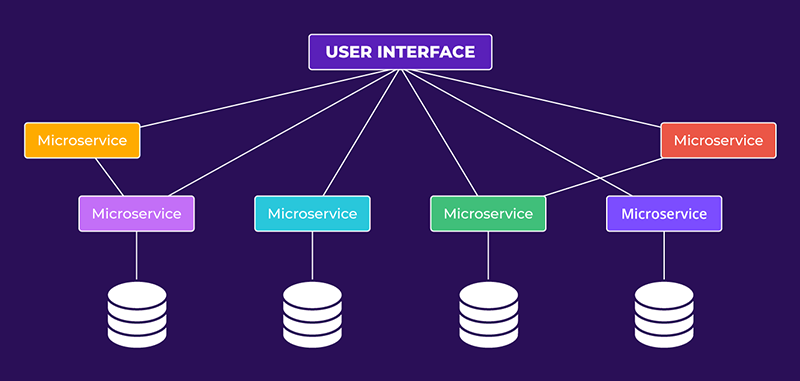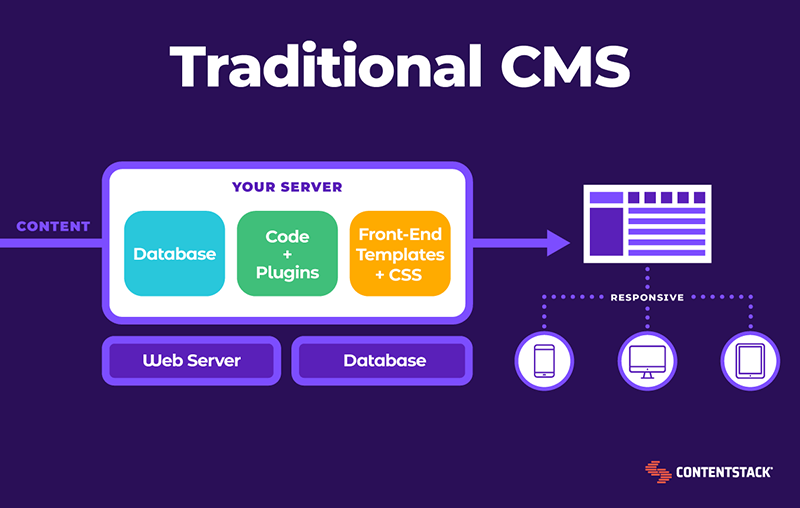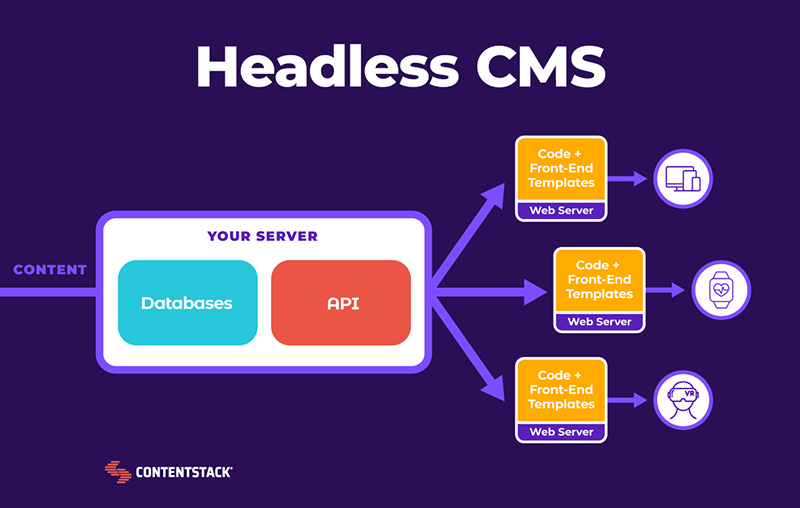Monolithic vs. microservices: why decoupled and headless architectures are the future

Monolithic architecture has served us well. In the early days of the web, companies needed a system to empower users to manage and deliver content. A monolithic architecture provided an all-in-one, or “coupled,” system with a codebase that pulled in everything necessary for managing and publishing content to the web.
However, when mobile internet usage began to exceed that of desktop around 2014, the “all-in-one” element of monolithic architecture became more hindrance than a helper. Businesses now needed to serve consumer experiences on a variety of devices and channels.
That’s why, today, there’s a new content management system (CMS) contender that may very well bring microservices-based software to the forefront of the digital experience landscape.
The following takes a closer look at monolithic vs. microservices architectures, as well as tips for choosing which solution is right for your business needs.
Understanding the basics of monolithic vs. microservices software

Despite its name, microservices architecture doesn’t mean it’s “small.” However, it is built to be lean. A microservices-based application consists of a suite of small services, each with its unique codebase. Microservices use lightweight mechanisms (such as an application program interface or API) to communicate between the various services. These services are focused on business goals you can deploy separately or together as needed through automation. There is very little centralized management of these services, making the system “decoupled” or headless because it does not function as one unified workflow.
What’s so appealing about a decoupled microservices architecture? For starters, some key advantages include:
Improved performance: With headless microservices, it’s easier to isolate specific services and grow them separately from the rest of the app as they’re performing well.
Less mess: The decoupling of services enables parallel development of the entire app with fewer breaks and overlaps between different services.
Enhanced configuration: It’s easier to reconfigure decoupled services to serve various functions, which allows for faster, independent delivery of specific portions within a larger whole.
Better organization: As each service has a precise role and its own codebase, microservices tend to have better overall organization among services.
When comparing monolithic vs. microservices solutions, microservices architecture can bring challenges. Challenges, such as cross-cutting concerns that span each service (which need individualized resolutions) to higher operational overhead. These concerns depend on how the systems are designed and leveraged, which varies significantly across situations.
Why your timing matters when deploying microservices architecture
Monolithic had its time to shine, but microservices architecture is in the spotlight now. Legions of software architects can’t resist the chance to break down monolithic software and build new delivery methods and pipelines full of small services with specific business purposes.
Due to the complexity of product chains and marketing content delivery, enterprise companies are adopting headless microservices. Even Amazon and Netflix have jumped on the bandwagon!
However popular microservices architecture gets, it’s notable that microservices aren’t always suitable for every situation.
Teams building new applications and looking to increase productivity while simplifying their workflow might be better served running traditional monolithic vs. microservices software. As product offerings and content become more complex, enabling a microservices architecture in place of a monolithic one becomes an essential future priority.
Timing does matter when deploying CMS solutions. Applications evolve. With greater size and scope, microservices start to make the most sense.
How headless architecture settles the monolithic vs. microservices debate
Let’s first make the term “headless” a bit less intimidating. Headless architecture (also called “decoupled”) is part of a broader trend in software and internet services toward linking specialized elements together through a unified network rather than a holistic software deployment. When it comes to monolithic vs. microservices software, the breakdown is:
- Monolithic = a traditional, all-in-one-style CMS
- Microservices = a headless, decoupled CMS

Headless architecture does the work of decoupling the frontend from the backend within a CMS. This separation allows users to store data in one place while sending it across many channels and services.

There are several excellent reasons for the growing shift towards headless architecture in the monolithic vs. microservices discussion. The biggest one is speed.
High-growth companies that are heavily internet-dependent and the widespread adoption of enterprise mobility have pushed companies to improve and update their applications constantly. Just think about how often your smartphone asks you to update the dozens of applications on it. Through decoupling, a company can separate the frontend, backend, and content to speed up new releases. In other words, constantly enhancing the user experience takes precedent with headless microservices architecture.
Another reason for the movement towards decoupled architecture is the push towards an omnichannel approach for content distribution. Omnichannel distribution calls for flexibility that doesn’t exist in traditional monolithic solutions because the frontend and backend are inextricably linked. Any changes on one end inevitably flow through the other. This approach costs resources and introduces risk.
When comparing monolithic and microservices software, a decoupled architecture reduces costs and risks while allowing for steady distribution across channels and an uninterrupted user experience. Together these reasons make a compelling case for the future of microservices architecture.
How to choose: monolithic vs. microservices content management systems
With a traditional, monolithic CMS, you know what you’re getting. That path has been well-traveled. You can expect fewer cross-cutting concerns (which happens in most applications) and likely less operational overheard as a monolith is in some cases less complex to deploy. Shared-memory access tends to be a bit faster than inter-process communication, so you’re not sacrificing speed and performance.
As the application evolves and gets more entangled, it can be challenging to isolate services and scale them independently — not to mention ongoing code maintenance challenges. Also, monolithic architecture can get quite complex, and the various side effects and dependencies are not always apparent.
MONOLITHIC | MICROSERVICES | |
| Do you have existing content management solutions and are you looking to grow your ecommerce offerings? | More offering requires larger effort | Growth of offerings easier |
| Are you content heavy and/or have content that is media-rich, rapidly evolving, or experiencing rapid growth? | Less ability to evolve content rapidly | More ability to evolve and grow content |
| Do you have experience marketing and content management capacities with a desire for more control? | Less experience, less control needed | Better with more experience, offers more control |
| Do you wish to deliver highly-personalized, one-to-one experiences with a more narrow approach to targeting? | Harder to personalize, targeting is limited | Allows for personalization, narrow targeting |
| Are you operating a large conglomerate with many subsidiary companies or divisions that need agency over their content guidelines and workflows? | Ideal if only managing content workflows for one large company | Allows sub-entities to manage workflows |
As we’ve shown below, there are pros and cons to each solution when comparing monolithic vs. microservices. How to decide which is better depends on your situation. With a deep understanding of your company’s unique use case, walking through the following questions should help you make the best choice between monolithic vs. microservices CMS.
As we hope we’ve demonstrated, there are many important considerations to discuss with your team when considering a monolithic vs. microservices software solution. We hope this article helps you navigate through all those key decision points.
If you are interested in learning even more about using a headless CMS to supercharge your content strategy, check out this
in-depth guide to all things headless CMSAbout Contentstack
The Contentstack team comprises highly skilled professionals specializing in product marketing, customer acquisition and retention, and digital marketing strategy. With extensive experience holding senior positions at renowned technology companies across Fortune 500, mid-size, and start-up sectors, our team offers impactful solutions based on diverse backgrounds and extensive industry knowledge.
Contentstack is on a mission to deliver the world’s best digital experiences through a fusion of cutting-edge content management, customer data, personalization, and AI technology. Iconic brands, such as AirFrance KLM, ASICS, Burberry, Mattel, Mitsubishi, and Walmart, depend on the platform to rise above the noise in today's crowded digital markets and gain their competitive edge.
In January 2025, Contentstack proudly secured its first-ever position as a Visionary in the 2025 Gartner® Magic Quadrant™ for Digital Experience Platforms (DXP). Further solidifying its prominent standing, Contentstack was recognized as a Leader in the Forrester Research, Inc. March 2025 report, “The Forrester Wave™: Content Management Systems (CMS), Q1 2025.” Contentstack was the only pure headless provider named as a Leader in the report, which evaluated 13 top CMS providers on 19 criteria for current offering and strategy.
Follow Contentstack on LinkedIn.




.svg?format=pjpg&auto=webp)
.svg?format=pjpg&auto=webp)
.png?format=pjpg&auto=webp)






.png?format=pjpg&auto=webp)

